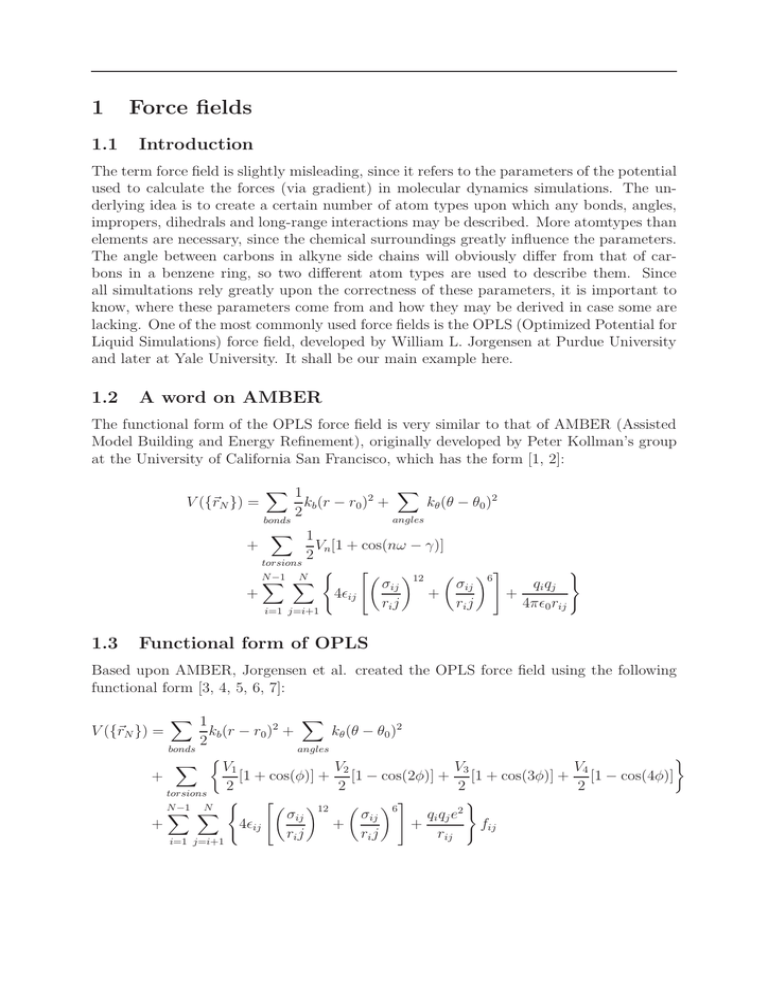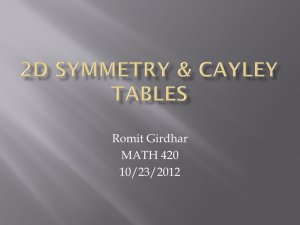1 Force fields
advertisement

1
1.1
Force fields
Introduction
The term force field is slightly misleading, since it refers to the parameters of the potential
used to calculate the forces (via gradient) in molecular dynamics simulations. The underlying idea is to create a certain number of atom types upon which any bonds, angles,
impropers, dihedrals and long-range interactions may be described. More atomtypes than
elements are necessary, since the chemical surroundings greatly influence the parameters.
The angle between carbons in alkyne side chains will obviously differ from that of carbons in a benzene ring, so two different atom types are used to describe them. Since
all simultations rely greatly upon the correctness of these parameters, it is important to
know, where these parameters come from and how they may be derived in case some are
lacking. One of the most commonly used force fields is the OPLS (Optimized Potential for
Liquid Simulations) force field, developed by William L. Jorgensen at Purdue University
and later at Yale University. It shall be our main example here.
1.2
A word on AMBER
The functional form of the OPLS force field is very similar to that of AMBER (Assisted
Model Building and Energy Refinement), originally developed by Peter Kollman’s group
at the University of California San Francisco, which has the form [1, 2]:
X
X 1
kθ (θ − θ0 )2
kb (r − r0 )2 +
2
angles
bonds
X 1
+
Vn [1 + cos(nω − γ)]
2
torsions
(
" )
6 #
N
−1 X
N
12
X
σij
qi qj
σij
+
4ǫij
+
+
r
j
r
j
4πǫ0 rij
i
i
i=1 j=i+1
V ({~rN }) =
1.3
Functional form of OPLS
Based upon AMBER, Jorgensen et al. created the OPLS force field using the following
functional form [3, 4, 5, 6, 7]:
X
X 1
kθ (θ − θ0 )2
kb (r − r0 )2 +
2
angles
bonds
X V1
V2
V3
V4
[1 + cos(φ)] + [1 − cos(2φ)] + [1 + cos(3φ)] + [1 − cos(4φ)]
+
2
2
2
2
torsions
(
"
#
)
12 6
N
N
−1 X
X
σij
qi qj e2
σij
4ǫij
+
+
fij
+
ri j
ri j
rij
i=1 j=i+1
V ({~rN }) =
1.4
Derivation of the parameters
Bonds and angles are described by harmonic potentials, since they are very strong
and fluctuate only slightly around their equilibrium values at room temperature. In many
simulations, bonds and even angles are constrained to fixed values to save computational
effort. The dihedral potential is described by a cosine expansion and may take any value
within 360◦ depending on the height of the barrier between the low energy conformations,
which makes the precision of the dihedral potential barrier crucial for many polymer
properties. Dihedral potentials always possess a symmetry around 180◦ . The long range
interactions are only counted for atoms three or more bonds apart. They are consist of
Coulomb and Lennard Jones two-body interaction terms. The Lennard Jones potential
is a combination of attractive van der Waals forces due to dipole-dipole interactions and
empirical repulsive forces due to Pauli repulsion. The scaling factor fij equals 0.5 for 1-4
interactions and one otherwise.
1.4
Derivation of the parameters
Since most molecular dynamics publications simply cite the force field used or give a list
of parameters without further explanation, this section shall shed some light on how these
parameters are found [1]. It should be noted, that in general any force field derivation
must start with very small molecules, such as CH3 , CH4 , or maybe benzene, to limit
the number of variables. Larger molecules can only be considered once the force field
parameters for most constituents are considered to be known.
1.4.1
Bonds and angles
The equilibrium values for bonds as well as angles are usually simply taken from x-ray
data. The values for the force constants are derived by fitting to experimental vibrational
frequency data. While one should actually go through a more complex procedure to ensure
that the geometries of simple molecules match experimental data as good as possible after
energy minimiztion, it is believed that in most cases the difference is negligible.
Fig. 1: Bond and angle between atoms i,j,k including corresponding force constants.
1.4
1.4.2
Derivation of the parameters
Dihedrals
First off, there are two different approaches as to how to calculate dihedral potentials.
One is to optimize the dihedral potential for the simplest possible molecule and then
apply it to larger ones containing the same dihedral, the other is to optimize the dihedral
parameters to best describe a large number of different molecules. Note that, while the
latter method might sound more accurate at first, it also leads to a dependence on the set
of chosen molecules. In both cases, the dihedral parameters are computed from ab initio
methods as follows [8]:
i. Ab initio calculations
• Scan dihedral (or improper) of interest
• Optimize geometry at each step
• Calculate change in potential energy
For this purpose, either perturbation (MP2), restricted Hartree-Fock (RHF) or hybrid methods between Hartree-Fock and density functional theory (B3LYP) are
used. The basis sets chosen for the geometry optimization are at least 6-31g and
may go up to 6-311g**, depending on the size of the molecule in question.
Fig. 2: Dihedral and improper between atoms i,j,k,l including corresponding force constants.
ii. Potential energy according to MD
• Set dihedral parameters to zero
• Compute potential energy of each optimized configuration
Note that this requires the knowledge of all other force field parameters in the
molecule.
iii. Fitting of the parameters
• Subtract MD from ab initio results
1.4
Derivation of the parameters
• Obtain parameters from fitting a dihedral function to the resulting curve
The difference between ab initio and MD results corresponds exactly to the influence
of the dihedral, since all other interactions are already included in the force field.
The most common mathematical representations of dihedrals are:
• Proper dihedrals
V ({r}) = Cn · (1 + cos(nφ))
• Ryckaert-Belleman dihedrals
V ({r}) =
5
X
Cn cosn (ψ)
n=0
where φ = ψ − 180◦.
iv. Checking the results
• Rerun MD simulations using new parameters
• Compare MD and ab initio results
1.4.3
Charges
To obtain the partial charges of a molecule in question, whose values will no longer be
altered during the MD runs (unless a polarizable force field is used), it is important to
make sure the charge calculations are done in the equilibrium, conformation. This may
be achieved by optimizing the geometry using any ab inito method with a basis set better
than or equal to 6-31G. The charges may then be obtained by fitting to the electrostatic
potential, i.e. adjusting the partial charges at the centers of the nuclei in such a fashion
that the electrostatic potential given by the wave functions is best reproduced. One of
the favored methods is CHELPG (CHarges from ELectrostatic Potentials using a Grid
based method) [9]. Charge calculations are often done using higher-level methods and
basis sets than the geometry optimization, e.g. B3LYP/cc-pVTZ or HF/6-31G**. There
are two known problems with this straigh-forward approach however: Firstly, oftentimes
considerable variation is seen when charges are computed for different conformations of
a molecules, which is especially problematic for molecules with multiple low energy conformations such as propylamine [10]. Secondly, standard electrostatic potential (ESP)
charges tend to miscalculate charges of ”buried” atoms, since they are statistically underdetermined and often assume too large values for nonpolar atoms. For these reasons,
the restricted ESP charge model was developed [11]. It consist of a least-squares fit of
the charges to the electrostatic potential (as before), but with hyperbolic restraints on
heavy atom charges. This is followed by a second fitting stage, needed to fit methyl
groups which require equivalent charges on hydrogen atoms which are not equivalent by
molecular symmetry.
1.5
Testing the force field
1.4.4
Van der Waals parameters
This is the area where the difference between OPLS/AMBER and other force fields
comes into play: Jorgensen et al. pioneered on creating force field parameters for organic molecules focusing on systems explicitely taking the solvent into account. As a
matter of fact, the OPLS/AMBER force field for peptides and proteins takes most bond,
angle and dihedral parameters from the force field developed by Weiner et al [12]. This is
achieved by carrying out Monte Carlo (MC) simulations of organic liquids, e.g. CH4 or
C2 H6 , and then empirically adjusting the Lennard Jones (σ and ǫ) parameters to match
the experimental densities and enthalpies of vaporization. A difficult issue is the factor to
scale down the Lennard Jones 1-4 interactions. It has to be done, since otherwise the r −12
term would lead to unphysically high repulsions. The value chosen is somewhat arbitrary
and force field dependent, however. The same holds true for the combination rules for the
Lennard Jones parameters, i.e. the choice of LJ parameters for the interaction between
two different atom types. There are two main competing methods:
• Lorentz-Bertelot
1
(σii + σjj )
2
ǫij = (ǫii ǫjj )1/2
σij =
• Geometrical average
σij = (σii σjj )1/2
ǫij = (ǫii ǫjj )1/2
The method should be chosen in accordance with the force field to be used.
1.5
Testing the force field
The validity of the force field can be tested in multiple ways. For proteins, it is important that the Ramachandran plots for the dihedral angles correspond to those obtained
experimentally to ensure sampling of the correct secondary structures in simulations. For
liquids, the radial distribution function as well as the density should be correctly reproduced. The radius of gyration and the persistence length are checked for polymer chains.
1.6
Some details for use with Gromacs
When one has chosen a force field to use with Gromacs it is important that some input
parameters for the simulations are in accordance with this force field. All important
settings may be found in the headers of the itp and rtp files. They are as follows:
1.6
Some details for use with Gromacs
1.6.1
itp-file
• nbfunc
type of non-bonded function to be used
⋆ 1: Lennard Jones (OPLS, AMBER)
⋆ 2: Buckingham
• comb-rule
combination rule to be used for non-bonded interactions
q
6
N
M
⋆ 1: Given C and C ⇒ Cij = CiM CjM
√
⋆ 2: σij = 21 (σ1 + σj ) and ǫij = ǫi ǫj (AMBER)
√
√
⋆ 3: σij = σ1 σj and ǫij = ǫi ǫj (OPLS)
• genpairs
generate LJ 1-4 pairs?
⋆ yes (OPLS, AMBER)
⋆ no
Note: do not add [pairtypes] section, if genpairs = yes
• fudgeLJ
scaling factor for LJ 1-4 interactions
⋆ 0.5 (OPLS, AMBER)
• fudgeQQ
scaling factor for Coulomb 1-4 interactions
⋆ 0.8333 (AMBER)
⋆ 0.5 (OPLS-UA)
⋆ 1/8 (OPLS-AA)
1.6.2
rtp-file
• bonds
function used to describe bonded potential
⋆ 1: bond (OPLS, AMBER)
⋆ 2: G96 bond
⋆ 3: morse
⋆ 4: cubic
1.6
Some details for use with Gromacs
⋆ 5: connection
⋆ 6: harmonic potential
⋆ 7: FENE
• angles
function used to describe angular potential
⋆ 1: angle (OPLS, AMBER)
⋆ 2: G96 angle
⋆ 3: quadratic angle
• dihedrals
function used to describe dihedral potential
⋆ 1: proper
⋆ 2: improper
⋆ 3: Ryckaert-Belleman (OPLS, AMBER)
• impropers
function used to describe improper potential
⋆ 1: proper (OPLS, AMBER)
⋆ 2: improper
⋆ 3: Ryckaert-Belleman
• all dihedrals
generate all dihedrals?
⋆ 0: only for heavy atoms
⋆ 1: yes (OPLS, AMBER)
• nrexcl
number of excluded neighbors for non-bonded interactions
⋆ 3 (default, should not be changed)
• HH14
generate 1-4 interaction pairs between hydrogens?
⋆ 0: no
⋆ 1: yes (OPLS, AMBER)
• RemoveDih
remove propers over the same bond as a improper?
REFERENCES
⋆ 0: no (OPLS, AMBER)
⋆ 1: yes
All above informations are based on Gromacs version 3.3.1.
References
[1] W. Cornell, P. Cieplak, P.A. Kollmann et al., J. Am. Chem. Soc. 117, 5179-5197
(1995).
[2] Y. Duan, C. Wu, P. Kollmann et al., J. Comp. Chem. 24, 1999-2012 (2003).
[3] W.L. Jorgensen and J. Tirado-Rives, J. Am. Chem. Soc. 110, 1657-1666 (1988).
[4] W.L. Jorgensen, D.S. Maxwell, and J. Tirado-Rives, J. Am. Chem. Soc. 118, 1122511236 (1996).
[5] W.L. Jorgensen, Encyclopedia of Comp. Chem., 1986-1988 (1998).
[6] W.L. Jorgensen, Encyclopedia of Comp. Chem., 1754-1762 (1998).
[7] W.L. Jorgensen and J. Tirado-Rives, PNAS 102, 6665-6670 (2005).
[8] A.D. Mackerell, J. Comp. Chem. 25, 1584-1604 (2004).
[9] C.M. Breneman,and K.B. Wiberg, J. Comp. Chem. 11, 361-373 (1989).
[10] W. Cornell, P. Cieplak, C. Bayly, and P.A. Kollmann, J. Am. Chem. Soc. 115,
9620-9631 (1993).
[11] C. Bayly, P. Cieplak, W. Cornell, and P.A. Kollmann, J. Phys. Chem. 97, 1026910280 (1993).
[12] S.J. Weiner, P.A. Kollmann, P.J. Weiner et al., J. Am. Chem. Soc. 106, 765-784
(1984).

